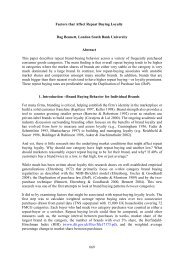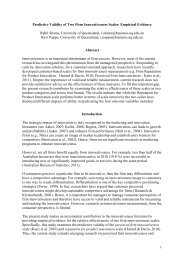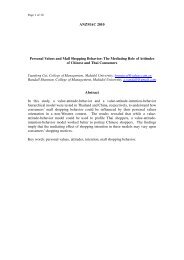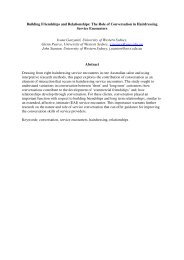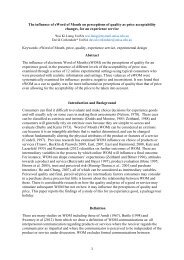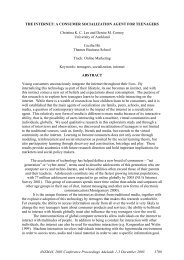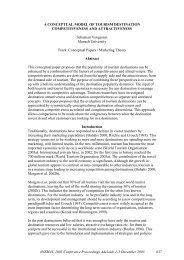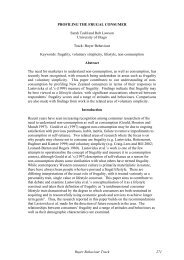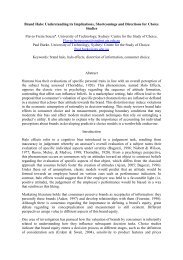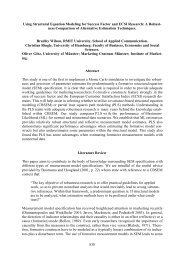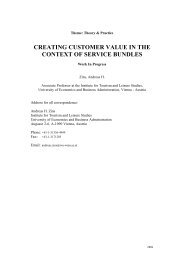improving the potential to forecast demand for wine by ... - ANZMAC
improving the potential to forecast demand for wine by ... - ANZMAC
improving the potential to forecast demand for wine by ... - ANZMAC
Create successful ePaper yourself
Turn your PDF publications into a flip-book with our unique Google optimized e-Paper software.
Epidemiology and Marketing<br />
There is some precedent <strong>for</strong> using epidemiological techniques in <strong>the</strong> marketing area.<br />
Indeed, <strong>the</strong> Bass Model (1969) draws on roots in epidemiology in describing <strong>the</strong><br />
manner in which a <strong>potential</strong> market adopts a new product, idea, concept over<br />
successive time periods (Mahajan and Muller 1979). However, <strong>the</strong> Bass model uses<br />
empirically generalised data <strong>to</strong> define patterns of adoption. In this study, <strong>the</strong> data is<br />
yet <strong>to</strong> be generated.<br />
In order <strong>to</strong> investigate patterns of consumption, a study needs <strong>to</strong> be conducted over a<br />
long period. Studies that use <strong>the</strong> same respondents over extended time-lines are<br />
known as longitudinal studies (Guest 1944, 1955, 1964; Alanko 1984; Kelsey,<br />
Thompson and Evans 1986; Hennekens and Buring 1987; Giovannucci, Colditz,<br />
Stampfer, Rimm, Litin, Sampson and Willett 1991; Shatzberg 1995; Neuman 1997;<br />
Godden 1999). The epidemiological methods of investigating respondents’<br />
behaviours over extended periods are a prospective cohort study, case-control study<br />
and retrospective cohort study. The details of each of <strong>the</strong>se methods are outlined<br />
below.<br />
A prospective cohort study [usually referred <strong>to</strong> as a cohort study] is where subjects<br />
are classified based on <strong>the</strong>ir exposure <strong>to</strong> a particular fac<strong>to</strong>r that is hypo<strong>the</strong>sised <strong>to</strong><br />
predetermine a course of action. The exposed and unexposed groups are <strong>the</strong>n<br />
moni<strong>to</strong>red over time <strong>for</strong> <strong>the</strong> development or o<strong>the</strong>rwise of <strong>the</strong> course of action being<br />
investigated (Hennekens and Buring 1987; Kahn and Sepos 1989).<br />
Retrospective studies are where an outcome is observed in a number of respondents.<br />
The respondents are questioned on <strong>the</strong>ir exposure or o<strong>the</strong>rwise <strong>to</strong> an [hypo<strong>the</strong>sised]<br />
influencing fac<strong>to</strong>r. Additionally, a comparable group of respondents who do not<br />
exhibit <strong>the</strong> outcome should also be queried as <strong>to</strong> any exposure <strong>to</strong> <strong>the</strong> influencing<br />
fac<strong>to</strong>r in an attempt <strong>to</strong> falsify a cause [or vice-versa] (Hennekens and Buring 1987;<br />
Kahn and Sepos 1989).<br />
“In a retrospective cohort study <strong>the</strong> investiga<strong>to</strong>r identifies a cohort of individuals based on <strong>the</strong>ir<br />
characteristics in <strong>the</strong> past and <strong>the</strong>n reconstructs <strong>the</strong>ir subsequent experience up <strong>to</strong> some defined point in<br />
<strong>the</strong> more recent past or up <strong>to</strong> <strong>the</strong> present time” (Kelsey et al. 1986)<br />
Retrospective cohort studies have advantages over prospective studies because cohort<br />
studies are conducted over long periods, and <strong>the</strong>re is a drop in respondent numbers<br />
over time. Consequently, any reduction in respondent numbers reduces <strong>the</strong><br />
generalisability of <strong>the</strong> results. Secondly, retrospective cohort studies can be<br />
completed in much more timely fashion and are considerably less expensive.<br />
Additionally, retrospective studies may be most applicable when extended timelines<br />
are required <strong>to</strong> determine effects (Kelsey et al. 1986).<br />
‘Exposure’ data may exist from previous periods, and in this instance, <strong>the</strong>y may be<br />
used <strong>to</strong> analyse <strong>the</strong> success of a retrospective study (Kahn and Sepos 1989). A<br />
problem of determining exposure <strong>to</strong> drivers of consumption in effect on an individual<br />
is that when using a retrospective study, <strong>the</strong> ability <strong>to</strong> apportion differing levels of<br />
exposure [<strong>to</strong> a driver of consumption] <strong>to</strong> individuals is not possible.<br />
<strong>ANZMAC</strong> 2003 Conference Proceedings Adelaide 1-3 December 2003 689



